The AMD Ryzen 7 5800X remains a formidable and popular CPU choice, striking a potent balance between multi-core productivity and high-end gaming performance. Built on the mature and stable AM4 platform, it offers tremendous value for builders. However, unlocking the full potential of this 8-core processor requires a crucial component: the right motherboard.
A motherboard acts as the central nervous system of your PC, connecting the CPU, RAM, GPU, and storage. The quality of its power delivery, cooling, and connectivity features directly impacts system stability and performance. For those wondering when you should upgrade your motherboard, pairing a new CPU like the 5800X with a capable board is a perfect time.
This guide provides a purely informational, expert analysis of 10 proven motherboards for the Ryzen 7 5800X. We will dissect their features, specifications, and current status to help you make a fully informed decision.
Understanding Key Considerations for Your Ryzen 7 5800X Motherboard
Before diving into specific models, it’s essential to understand the core features that differentiate them. A grasp of these concepts will empower you to choose a board that aligns perfectly with your needs and budget.
Chipset Showdown: B550 vs. X570—Which Is Right for You?
The chipset is the heart of the motherboard, and its primary function is to manage data flow between the CPU and other components. For the Ryzen 7 5800X, the main choices are the B550 and X570 chipsets.
- B550 Chipset: The B550 is the mainstream chipset for the Ryzen 5000 series. It offers direct-from-CPU PCIe 4.0 support for one graphics card and one M.2 NVMe SSD. The chipset’s own downstream lanes are PCIe 3.0. For the vast majority of users, including dedicated gamers and content creators, the B550 chipset provides all the necessary features and performance at a more accessible price point.
- X570 Chipset: The X570 is the enthusiast-grade chipset. Its main advantage is providing PCIe 4.0 connectivity for both the CPU-connected slots and the general-purpose lanes from the chipset itself. This means you can run multiple high-speed PCIe 4.0 SSDs and other expansion cards simultaneously. This is ideal for power users with extensive storage needs or unique expansion card setups. You can explore a detailed comparison in our B550 vs. X570 guide.
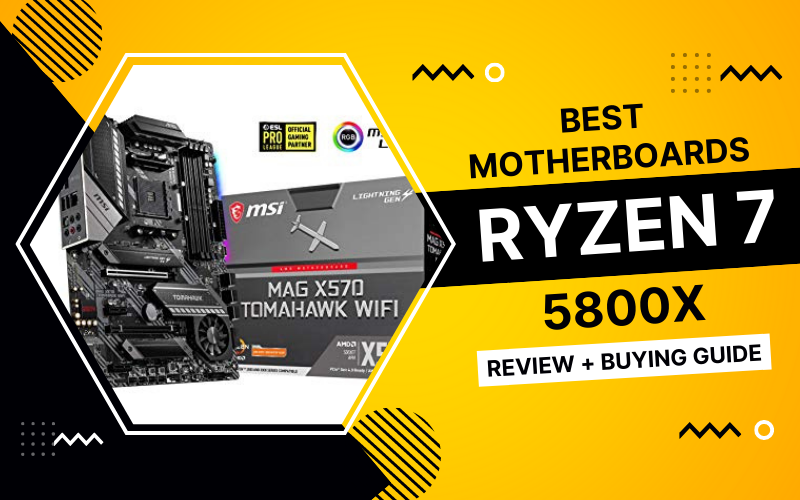
Form Factor Fundamentals: ATX, Micro-ATX, and Mini-ITX
A motherboard’s form factor determines its physical size and, consequently, the number of expansion slots and features it can accommodate.
- ATX: The most common size, offering a balanced mix of features and expansion slots, including multiple PCIe slots and up to four RAM slots. It’s the standard for most mid-tower and full-tower PC cases.
- Micro-ATX (mATX): A shorter version of ATX, offering fewer PCIe slots but often retaining four RAM slots. It’s a great option for more compact builds without sacrificing core functionality.
- Mini-ITX (ITX): The smallest standard form factor, designed for space-constrained builds. It typically has only one PCIe slot for a graphics card and two RAM slots, making component selection more critical.
For a deeper dive into these sizes, our article on Micro-ATX vs. Mini-ITX vs. ATX provides a complete breakdown.
Why VRM and Power Delivery Matter for the 5800X
The Voltage Regulator Module (VRM) is a critical system that converts the 12V power from your PSU into the precise, lower voltage your CPU requires. A robust VRM ensures stable power delivery, especially under load, which is essential for achieving the 5800X’s maximum boost clocks and maintaining system stability. A quality VRM is a key factor if you do you need a good motherboard for gaming.
Essential Connectivity: PCIe, M.2, USB, and Networking
- PCIe Slots: These are used for expansion cards like GPUs, sound cards, and capture cards. A motherboard should have at least one full-size PCIe x16 slot for the graphics card.
- M.2 Slots: These provide the fastest storage connection for NVMe SSDs. Aim for at least two M.2 slots, with one supporting PCIe 4.0 speeds to take full advantage of the latest drives. Understanding how many M.2 slots on a motherboard you need is key for planning your storage.
- USB Ports: Check the rear I/O panel for a sufficient number and type of USB ports (Type-A, Type-C, USB 3.2 Gen 2) to meet your peripheral needs.
- Networking: A 2.5 Gbps LAN port is becoming the new standard for wired connections, offering a significant speed advantage over older 1 Gbps Ethernet. For wireless, Wi-Fi 6 or 6E provides the best performance.
Comparison of the Top 10 Motherboards for the Ryzen 7 5800X
This table provides a high-level overview of the key specifications for each motherboard discussed in this guide.
| Feature | ASUS TUF Gaming X570-Plus | MSI B550 TOMAHAWK MAX | ASUS ROG Strix X570-E Gaming | MSI MPG X570 GAMING PLUS | Gigabyte X570 AORUS Elite | MSI MPG X570S EDGE MAX WIFI | Gigabyte B550M AORUS PRO-AX | ASUS ROG Strix X570-I | MSI MEG X570 UNIFY | ASUS ROG Crosshair VIII Formula |
| Chipset | AMD X570 | AMD B550 | AMD X570 | AMD X570 | AMD X570 | AMD X570S | AMD B550 | AMD X570 | AMD X570 | AMD X570 |
| Form Factor | ATX | ATX | ATX | ATX | ATX | ATX | Micro-ATX | Mini-ITX | ATX | ATX |
| VRM Phases | 12+2 | 10+2+1 | 12+4 | 8+2 | 12+2 | 12+2 | 12+2 | 8+2 | 12+2+1 | 14+2 |
| Memory Support | 4x DDR4, 128GB | 4x DDR4, 128GB | 4x DDR4, 128GB | 4x DDR4, 128GB | 4x DDR4, 128GB | 4x DDR4, 128GB | 4x DDR4, 128GB | 2x DDR4, 64GB | 4x DDR4, 128GB | 4x DDR4, 128GB |
| PCIe x16 Slot | 1x PCIe 4.0 | 1x PCIe 4.0 | 2x PCIe 4.0 | 1x PCIe 4.0 | 1x PCIe 4.0 | 1x PCIe 4.0 | 1x PCIe 4.0 | 1x PCIe 4.0 | 2x PCIe 4.0 | 2x PCIe 4.0 |
| M.2 Slots | 2x (1x Gen4) | 2x (1x Gen4) | 2x (2x Gen4) | 2x (1x Gen4) | 2x (1x Gen4) | 3x (3x Gen4) | 2x (1x Gen4) | 2x (2x Gen4) | 3x (3x Gen4) | 2x (2x Gen4) |
| SATA Ports | 8 | 6 | 8 | 6 | 6 | 6 | 6 | 4 | 4 | 8 |
| LAN Speed | 1 Gbps | 2.5 Gbps + 1 Gbps | 2.5 Gbps | 1 Gbps | 1 Gbps | 2.5 Gbps | 2.5 Gbps | 1 Gbps | 2.5 Gbps | 5 Gbps + 1 Gbps |
| Wi-Fi | Wi-Fi 5 | Wi-Fi 6 | Wi-Fi 6 | No | No | Wi-Fi 6E | Wi-Fi 6 | Wi-Fi 6 | Wi-Fi 6 | Wi-Fi 6 |
| Audio Codec | Realtek S1200A | Realtek ALC1200 | ROG SupremeFX S1220A | Realtek ALC1220 | Realtek ALC1200 | Realtek ALC4080 | Realtek ALC1200 | ROG SupremeFX S1220A | Realtek ALC1220 | ROG SupremeFX S1220 |
Detailed Analysis of 10 Proven Motherboards for the Ryzen 7 5800X
Here we examine each board’s characteristics, ideal use case, and current market standing.
1. ASUS TUF Gaming X570-Plus (Wi-Fi)
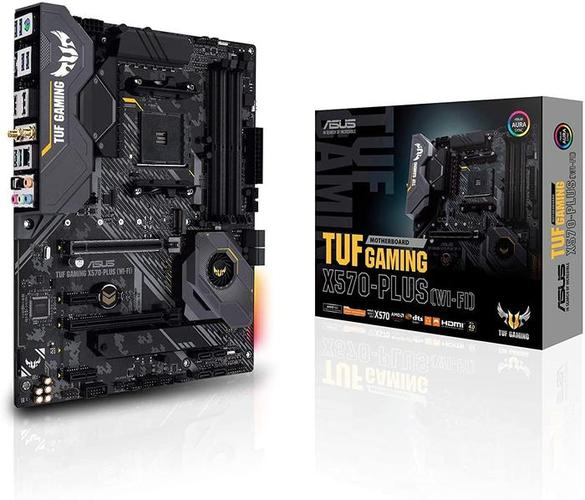
The ASUS TUF Gaming line is known for its focus on durability and reliability, using military-grade components to ensure a long lifespan. This board represents a balanced entry into the X570 chipset, offering PCIe 4.0 support across multiple slots without an exorbitant price tag.
Key Specifications
- Chipset: AMD X570
- Form Factor: ATX
- VRM: 12+2 Dr. MOS power stages
- Memory: 4x DDR4 slots, up to 128GB
- Storage: 2x M.2 slots, 8x SATA 6Gb/s ports
- Networking: Realtek L8200A 1Gb LAN, Intel Wi-Fi 5
Objective Analysis
The TUF Gaming X570-Plus provides a robust 12+2 phase VRM that is more than capable of handling the Ryzen 7 5800X, even with moderate overclocking. Its feature set is practical, with dual M.2 slots (one Gen4, one Gen3), ample SATA ports, and decent audio. The primary drawback by standards is the inclusion of 1Gbps LAN and Wi-Fi 5, which are a step behind the current 2.5Gbps and Wi-Fi 6/6E standards.
Current Status
This model is still widely available and remains a popular budget-conscious X570 choice. However, ASUS has released a newer TUF Gaming X570-PRO (Wi-Fi) version, which upgrades the networking to 2.5Gbps LAN and Wi-Fi 6. For a new build, the “PRO” version is the more logical choice if the price is comparable.
2. MSI MAG B550 TOMAHAWK MAX WIFI
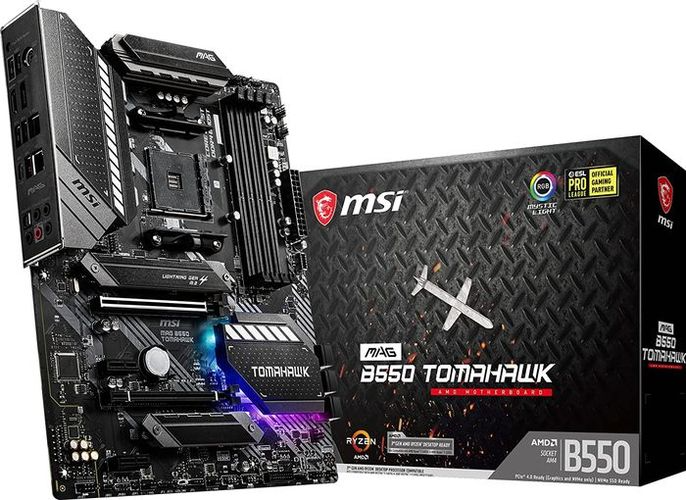
The MSI Tomahawk series has long been a benchmark for performance and value in the mainstream motherboard market. The B550 Tomahawk continues this legacy, offering a premium feature set that rivals some X570 boards, making it a go-to choice for gamers.
Key Specifications
- Chipset: AMD B550
- Form Factor: ATX
- VRM: 10+2+1 Duet Rail Power System
- Memory: 4x DDR4 slots, up to 128GB
- Storage: 2x M.2 slots, 6x SATA 6Gb/s ports
- Networking: Realtek 2.5Gbps LAN + 1Gbps LAN, Wi-Fi 6
Objective Analysis
This board is exceptionally well-equipped for a B550 model. The strong VRM handles the 5800X with ease, and the extended heatsink design ensures it stays cool. Its standout features are the dual LAN ports (one 2.5Gbps, one 1Gbps) and integrated Wi-Fi 6, which provide excellent networking flexibility. The inclusion of a PCIe 4.0 M.2 slot and a PCIe 4.0 x16 slot covers the high-speed needs of any modern gaming rig.
Current Status
The MSI MAG B550 TOMAHAWK MAX WIFI is the current, definitive version of this model. It is readily available and remains one of the most frequently recommended motherboards for the Ryzen 7 5800X due to its superb balance of features, performance, and price.
3. ASUS ROG Strix X570-E Gaming
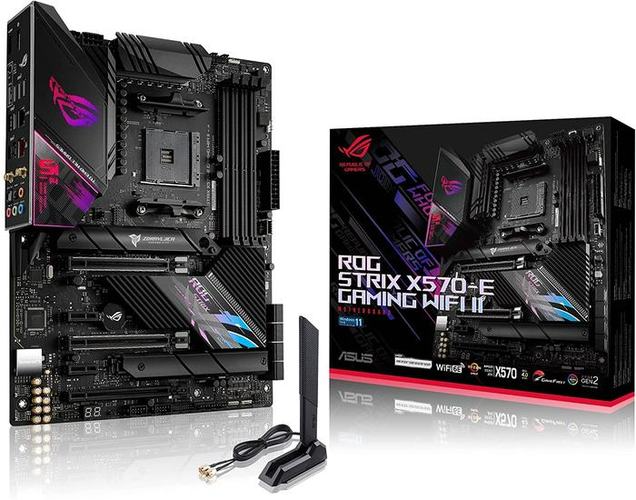
Positioned in the upper tier of the Republic of Gamers (ROG) lineup, the Strix X570-E Gaming is designed for enthusiasts who want premium features, robust power delivery, and signature ROG aesthetics without moving into the extreme price territory of the Crosshair series.
Key Specifications
- Chipset: AMD X570
- Form Factor: ATX
- VRM: 12+4 power stages
- Memory: 4x DDR4 slots, up to 128GB
- Storage: 2x M.2 slots (both PCIe 4.0), 8x SATA 6Gb/s ports
- Networking: Intel 2.5Gbps LAN, Wi-Fi 6
Objective Analysis
The Strix X570-E delivers on its premium promise with a powerful 16-stage VRM and comprehensive cooling that can handle heavy overclocking on the 5800X. It takes full advantage of the X570 chipset, offering dual PCIe 4.0 M.2 slots. The inclusion of high-end audio (SupremeFX S1220A), 2.5Gbps LAN, and Wi-Fi 6 rounds out a feature set that leaves little to be desired.
Current Status
The original Strix X570-E Gaming can still be found, but it has been largely superseded by the ASUS ROG Strix X570-E Gaming WiFi II. This updated version features improved VRM cooling and an upgraded audio codec. For a new purchase, the “WiFi II” is the recommended version to seek out.
4. MSI MPG X570 GAMING PLUS
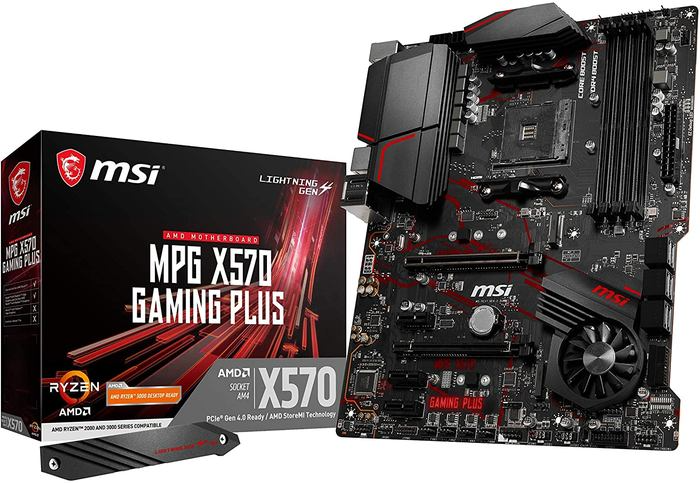
The MSI MPG X570 GAMING PLUS was designed as an accessible entry point into the X570 platform, providing core PCIe 4.0 functionality for users who didn’t need the premium bells and whistles of higher-end models.
Key Specifications
- Chipset: AMD X570
- Form Factor: ATX
- VRM: 8+2 power stages
- Memory: 4x DDR4 slots, up to 128GB
- Storage: 2x M.2 slots, 6x SATA 6Gb/s ports
- Networking: Realtek RTL8111H 1Gb LAN
Objective Analysis
This board provides the fundamental benefits of the X570 chipset, including a PCIe 4.0 x16 slot and one PCIe 4.0 M.2 slot. However, its VRM is less robust compared to others on this list, and it lacks modern features like 2.5Gbps LAN and Wi-Fi. While it can run a Ryzen 7 5800X at stock speeds, it is not ideal for significant overclocking.
Current Status
This motherboard is largely considered discontinued and is difficult to find new. For users considering this board, the MSI MAG B550 Tomahawk is a far superior alternative, offering a stronger VRM, better cooling, and vastly improved networking for a similar or lower price.
5. Gigabyte X570 AORUS Elite
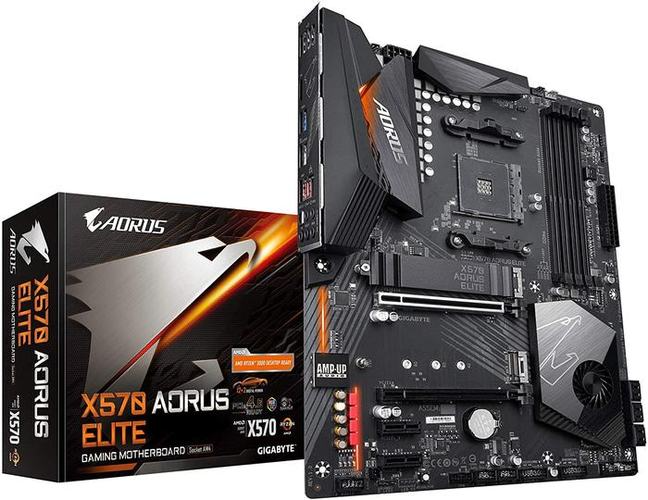
Gigabyte’s AORUS Elite series targets the mid-range sweet spot, blending performance-oriented features with aggressive gaming aesthetics. The X570 AORUS Elite was a popular choice for its strong VRM and value proposition within the X570 landscape.
Key Specifications
- Chipset: AMD X570
- Form Factor: ATX
- VRM: 12+2 phase digital VRM
- Memory: 4x DDR4 slots, up to 128GB
- Storage: 2x M.2 slots, 6x SATA 6Gb/s ports
- Networking: Intel 1Gbps LAN
Objective Analysis
The standout feature of the AORUS Elite is its powerful 12+2 phase VRM, which is excellent for handling the Ryzen 7 5800X. It also features a large, effective heatsink for cooling. Like some other early X570 boards, its primary weakness is the now-dated 1Gbps LAN port and the lack of integrated Wi-Fi. The I/O shield is also integrated, which simplifies the process of how to install motherboard drivers and the physical build.
Current Status
The original X570 AORUS Elite has been succeeded by the Gigabyte X570S AORUS ELITE AX. The “S” model is a significant upgrade, featuring a fanless chipset heatsink for silent operation, 2.5Gbps LAN, and Wi-Fi 6. The X570S version is the highly recommended alternative.
6. MSI MPG X570S EDGE MAX WIFI
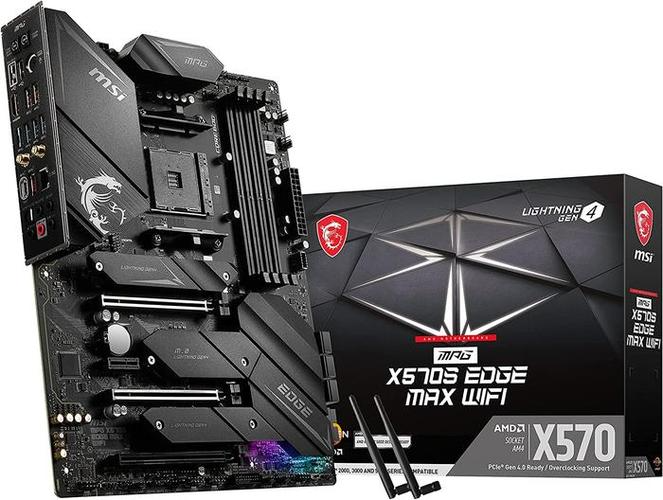
The “X570S” lineup from MSI represented a mid-generation refresh, with the most significant change being the removal of the often-noisy chipset fan in favor of a large, passive heatsink. The EDGE model balances high-end features with a sleek, non-RGB design.
Key Specifications
- Chipset: AMD X570S (fanless)
- Form Factor: ATX
- VRM: 12+2 Duet Rail Power System
- Memory: 4x DDR4 slots, up to 128GB
- Storage: 3x M.2 slots (all PCIe 4.0), 6x SATA 6Gb/s ports
- Networking: Realtek 2.5Gbps LAN, Wi-Fi 6E
Objective Analysis
This motherboard is a fantastic all-around performer for the Ryzen 7 5800X. The silent, fanless chipset is a major quality-of-life improvement. Its power delivery is robust, and it offers an impressive three PCIe 4.0 M.2 slots, providing extensive high-speed storage potential. The inclusion of cutting-edge Wi-Fi 6E and 2.5Gbps LAN makes it a future-proof choice for networking.
Current Status
This model is readily available and is one of the best X570-class boards to pair with a 5800X. Its modern feature set and silent operation make it a compelling choice over older, fan-equipped X570 motherboards.
7. Gigabyte B550M AORUS PRO-P
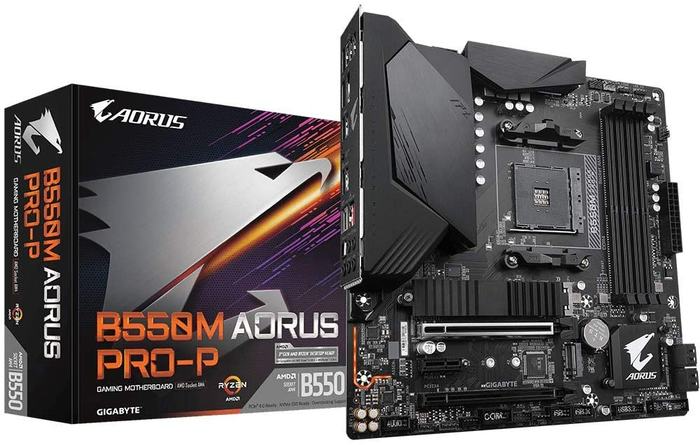
For those who prefer smaller builds without major compromises, the B550M AORUS PRO-AX packs a surprising number of features into a compact Micro-ATX form factor. It proves that a smaller board doesn’t have to mean a weaker system.
Key Specifications
- Chipset: AMD B550
- Form Factor: Micro-ATX
- VRM: 12+2 phase digital VRM
- Memory: 4x DDR4 slots, up to 128GB
- Storage: 2x M.2 slots, 6x SATA 6Gb/s ports
- Networking: Realtek 2.5Gbps LAN, Wi-Fi 6
Objective Analysis
It is impressive to see a 12+2 phase VRM on a Micro-ATX board, a feature that ensures this compact model can power the Ryzen 7 5800X as effectively as its full-sized ATX counterparts. It retains key modern features, including 2.5Gbps LAN, Wi-Fi 6, and dual M.2 slots (one Gen4). This makes it an ideal foundation for a powerful yet space-saving build inside a best micro ATX case.
Current Status
The B550M AORUS PRO-AX is the most current and feature-rich version of this model. It remains a top-tier choice for Micro-ATX AM4 builds and is widely available.
8. ASUS ROG Strix X570-I Gaming
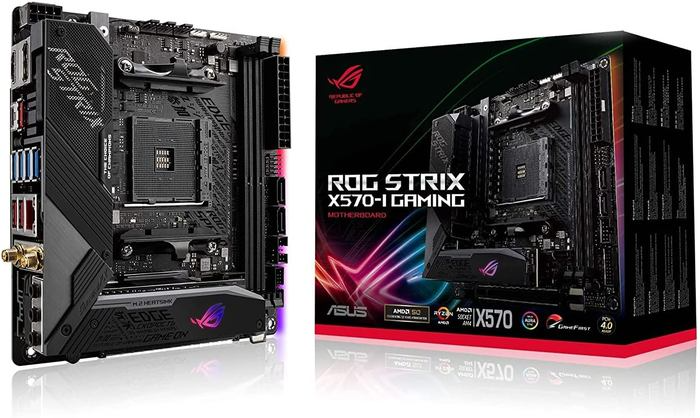
The Mini-ITX form factor presents a significant engineering challenge: fitting enthusiast-grade features onto a tiny 17cm x 17cm PCB. The ROG Strix X570-I rises to this challenge, creating a miniature powerhouse for small form factor (SFF) enthusiasts.
Key Specifications
- Chipset: AMD X570
- Form Factor: Mini-ITX
- VRM: 8+2 power stages
- Memory: 2x DDR4 slots, up to 64GB
- Storage: 2x M.2 slots (both PCIe 4.0), 4x SATA 6Gb/s ports
- Networking: Intel 1Gbps LAN, Wi-Fi 6
Objective Analysis
This board is an engineering marvel, featuring a robust VRM with active cooling and dual PCIe 4.0 M.2 slots (one on the front, one on the back). It takes full advantage of the X570 chipset’s capabilities in the smallest possible footprint. The main compromises are the single PCIe x16 slot, two RAM slots, and the older 1Gbps LAN port.
Current Status
This board is becoming increasingly rare and expensive. For a new Mini-ITX build, the ASUS ROG Strix B550-I Gaming is a more practical and readily available alternative. It offers 2.5Gbps LAN and a similarly strong VRM, making it a better value proposition for most SFF builders pairing with a 5800X.
9. MSI MEG X570 UNIFY
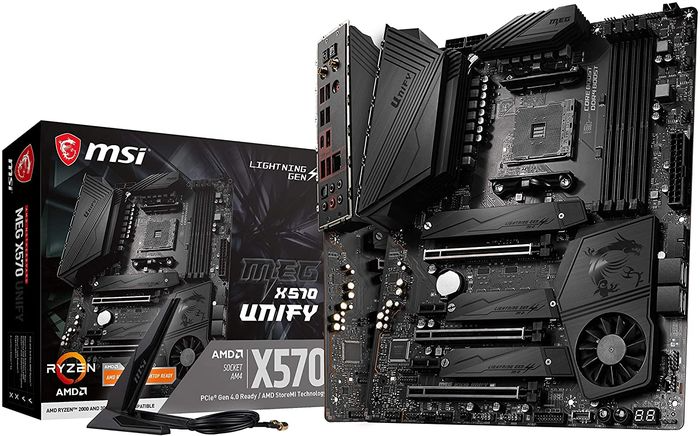
The MSI Unify series is aimed directly at overclockers and performance enthusiasts who prioritize raw power over aesthetics. It famously features a completely blacked-out design with zero RGB lighting, dedicating all of its budget to performance components.
Key Specifications
- Chipset: AMD X570
- Form Factor: ATX
- VRM: 12+2+1 power stages
- Memory: 4x DDR4 slots, up to 128GB
- Storage: 3x M.2 slots, 4x SATA 6Gb/s ports
- Networking: Realtek 2.5Gbps LAN, Wi-Fi 6
Objective Analysis
The MEG X570 Unify is built for performance. It features an exceptional VRM, triple M.2 slots with heavy-duty “Frozr” heatsinks, and a full suite of overclocking tools accessible within the BIOS. For those looking to push their Ryzen 7 5800X to its absolute limits while maintaining rock-solid stability, this board is an outstanding tool.
Current Status
Much like other early X570 boards, the original Unify has been updated. The successor to look for is the MSI MEG X570S UNIFY-X MAX. This version features the superior fanless chipset design and other refinements, making it the definitive choice for an RGB-free, performance-focused build.
10. ASUS ROG Crosshair VIII Formula
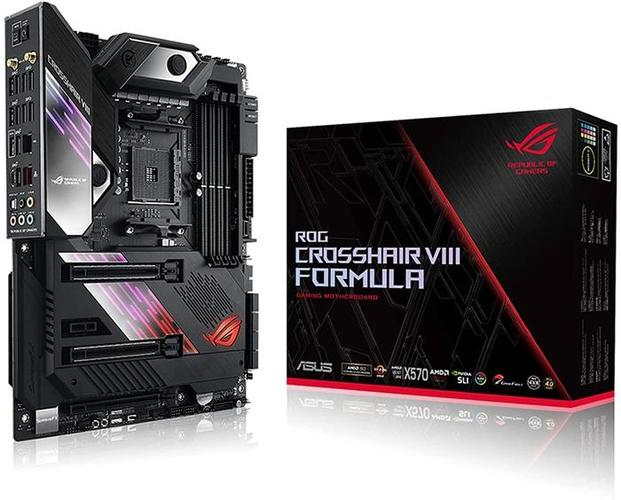
Sitting near the apex of the AM4 platform, the Crosshair VIII Formula is an enthusiast’s dream, built with exotic features and an uncompromising approach to performance and design. It is designed for custom loop water cooling and showcase builds.
Key Specifications
- Chipset: AMD X570
- Form Factor: ATX
- VRM: 14+2 power stages with integrated CrossChill EK III water block
- Memory: 4x DDR4 slots, up to 128GB
- Storage: 2x M.2 slots, 8x SATA 6Gb/s ports
- Networking: Aquantia 5Gbps LAN + Intel 1Gbps LAN, Wi-Fi 6
Objective Analysis
The defining feature of the Formula is its custom-engineered CrossChill EK III VRM block, designed in partnership with EKWB. This allows the VRM to be integrated directly into a custom water-cooling loop for unparalleled thermal performance. It also includes premium features like 5Gbps LAN and a vast array of onboard controls. For a Ryzen 7 5800X, this level of hardware is significant overkill, as the CPU’s power draw doesn’t necessitate such extreme cooling. This board is better suited for flagship CPUs like the Ryzen 9 5950X.
Current Status
This motherboard is extremely difficult to find new and commands a very high price on the secondary market. It is a specialty item for dedicated water-cooling enthusiasts. For almost all users, its cost and feature set are far beyond what is necessary or practical for a Ryzen 7 5800X.
Key Takeaway: The quality of a motherboard’s components is paramount. Knowing what are motherboard standoffs and ensuring proper installation is just as important as selecting a board with a good feature set to prevent electrical shorts.
Frequently Asked Questions (FAQ)
Is the AMD Ryzen 7 5800X still a good processor?
Absolutely. The Ryzen 7 5800X, with its 8 cores and 16 threads, continues to provide excellent performance for high-refresh-rate gaming and demanding multi-threaded applications. While newer platforms exist, the AM4 ecosystem offers exceptional performance-per-dollar, making the 5800X a very smart choice for new builds and upgrades.
Do I need an X570 motherboard for the Ryzen 7 5800X, or is B550 enough?
For the vast majority of users, a quality B550 motherboard is more than sufficient. It provides all the necessary PCIe 4.0 support for a primary GPU and NVMe SSD. You should only opt for an X570 or X570S board if you have a specific need for PCIe 4.0 speeds across multiple M.2 slots and expansion cards simultaneously. Our B550 vs. X570 breakdown can help you decide.
Will I need to update my motherboard’s BIOS to use a Ryzen 7 5800X?
Virtually all new B550 and X570 motherboards sold will ship from the factory with a BIOS version that supports the Ryzen 5000 series out of the box. If you purchase a board that has been in old stock for a very long time, it might require an update. Many boards feature a “BIOS FlashBack” function that allows you to update the motherboard BIOS without a CPU installed.
What is the most important component on a motherboard for gaming?
For gaming performance, the most critical aspects are a stable VRM to deliver consistent power to the CPU and a PCIe x16 slot running at its full speed for the graphics card. After that, fast RAM support and modern connectivity for storage (M.2) and networking are important. Ultimately, the motherboard ensures all your high-performance parts, like the best CPU for the RTX 3070, can communicate effectively and without bottlenecks.
What RAM speed is optimal for a Ryzen 7 5800X?
The sweet spot for performance and value with Ryzen 5000 series CPUs is DDR4 RAM running at 3600MHz with a CAS Latency (CL) of 16 or 18. This speed allows the Infinity Fabric Clock (FCLK) to run at a 1:1 ratio, minimizing latency and maximizing performance. You can find excellent options in our guide to the best RAM for Ryzen 5000 series CPUs.
How many M.2 slots are sufficient for a modern build?
For most users, two M.2 slots are sufficient. This allows for one very fast NVMe SSD for the operating system and key applications, and a second for games and frequently accessed files. Power users or content creators who work with large files might benefit from three or more M.2 slots, a feature more common on X570S motherboards.

Holding a Ph.D. in Computer Science, Dr. Alistair Finch is our chief PC Component Benchmark Analyst. He provides meticulous, data-driven analysis of CPUs and GPUs, moving beyond marketing claims to reveal their true performance. His guides help readers understand the intricate relationship between hardware architecture and real-world gaming frame rates.
